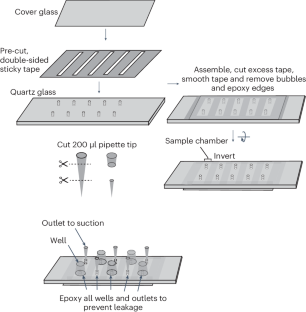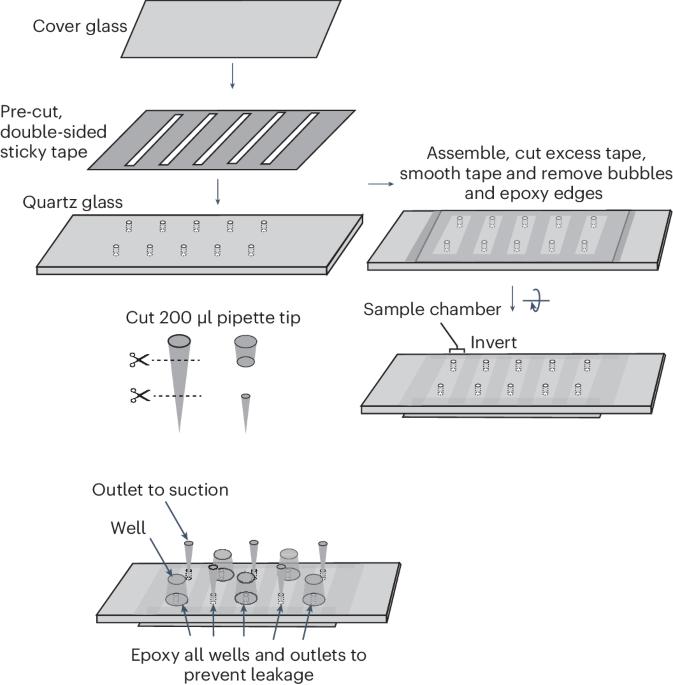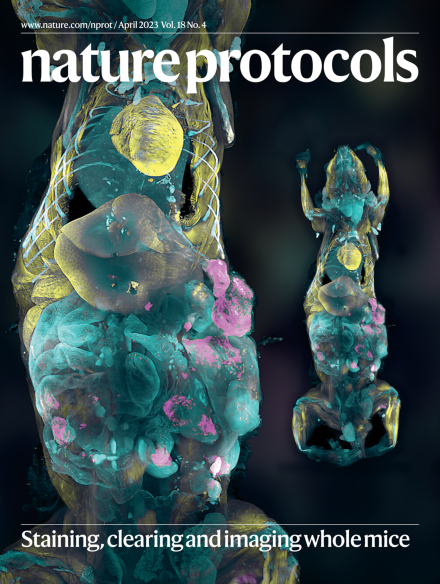观察体内孤立突触小泡的结合与融合
IF 13.1
1区 生物学
Q1 BIOCHEMICAL RESEARCH METHODS
引用次数: 0
摘要
在此,我们介绍一种从整鼠脑组织中分离功能完整的谷氨酸能突触小泡的方法,并将其用于单小泡试验,以检验它们与质膜模拟小泡的关联和融合。我们以前的实验方案是由脂质体中的重组蛋白组成的纯合成系统,本实验方案是在此基础上的扩展。我们还介绍了一种基于囊泡谷氨酸转运体的多肽的生成方法,这种多肽在谷氨酸能突触小泡的分离过程中至关重要。这种方法使用容易获得的试剂,通过免疫分离生成融合能力强的谷氨酸能突触小泡。vGlut 肽的生成可在 6 天内完成,而使用该肽分离突触小泡可在 2 天内完成,另外还需要一天时间对突触小泡进行荧光标记,以便用于单突触小泡混合融合试验。单突触小泡融合试验可在 1 天内完成,并能明确划分突触小泡的结合、解离、Ca2+ 依赖性和 Ca2+ 非依赖性融合模式。这种检测方法既能控制突触小泡的环境,又能保留突触小泡本身的复杂性。该方案可用于研究其他类型的突触小泡,或更广泛的不同分泌或运输小泡。这里描述的工作流程需要生物化学技术方面的专业知识,尤其是蛋白质纯化和荧光成像。我们假设实验室拥有蛋白质纯化设备,包括色谱系统。本文章由计算机程序翻译,如有差异,请以英文原文为准。


Observing isolated synaptic vesicle association and fusion ex vivo
Here, we present a protocol for isolating functionally intact glutamatergic synaptic vesicles from whole-mouse brain tissue and using them in a single-vesicle assay to examine their association and fusion with plasma membrane mimic vesicles. This is a Protocol Extension, building on our previous protocol, which used a purely synthetic system comprised of reconstituted proteins in liposomes. We also describe the generation of a peptide based on the vesicular glutamate transporter, which is essential in the isolation process of glutamatergic synaptic vesicles. This method uses easily accessible reagents to generate fusion-competent glutamatergic synaptic vesicles through immunoisolation. The generation of the vGlut peptide can be accomplished in 6 d, while the isolation of the synaptic vesicles by using the peptide can be accomplished in 2 d, with an additional day to fluorescently label the synaptic vesicles for use in a single-vesicle hybrid fusion assay. The single-vesicle fusion assay can be accomplished in 1 d and can unambiguously delineate synaptic vesicle association, dissociation, Ca2+-independent and Ca2+-dependent fusion modalities. This assay grants control of the synaptic vesicle environment while retaining the complexity of the synaptic vesicles themselves. This protocol can be adapted to studies of other types of synaptic vesicles or, more generally, different secretory or transport vesicles. The workflow described here requires expertise in biochemistry techniques, in particular, protein purification and fluorescence imaging. We assume that the laboratory has protein-purification equipment, including chromatography systems. The authors present a protocol for isolating functionally intact glutamatergic synaptic vesicles from whole-mouse brain tissue and using them in a single-vesicle fusion assay to examine their association and fusion with plasma membrane mimic vesicles.
求助全文
通过发布文献求助,成功后即可免费获取论文全文。
去求助
来源期刊

Nature Protocols
生物-生化研究方法
CiteScore
29.10
自引率
0.70%
发文量
128
审稿时长
4 months
期刊介绍:
Nature Protocols focuses on publishing protocols used to address significant biological and biomedical science research questions, including methods grounded in physics and chemistry with practical applications to biological problems. The journal caters to a primary audience of research scientists and, as such, exclusively publishes protocols with research applications. Protocols primarily aimed at influencing patient management and treatment decisions are not featured.
The specific techniques covered encompass a wide range, including but not limited to: Biochemistry, Cell biology, Cell culture, Chemical modification, Computational biology, Developmental biology, Epigenomics, Genetic analysis, Genetic modification, Genomics, Imaging, Immunology, Isolation, purification, and separation, Lipidomics, Metabolomics, Microbiology, Model organisms, Nanotechnology, Neuroscience, Nucleic-acid-based molecular biology, Pharmacology, Plant biology, Protein analysis, Proteomics, Spectroscopy, Structural biology, Synthetic chemistry, Tissue culture, Toxicology, and Virology.
 求助内容:
求助内容: 应助结果提醒方式:
应助结果提醒方式:


